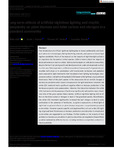Long‐term effects of artificial nighttime lighting and trophic complexity on plant biomass and foliar carbon and nitrogen in a grassland community
| dc.contributor.author | Anic, V | |
| dc.contributor.author | Gaston, KJ | |
| dc.contributor.author | Davies, Thomas | |
| dc.contributor.author | Bennie, J | |
| dc.date.accessioned | 2022-08-08T15:58:53Z | |
| dc.date.available | 2022-08-08T15:58:53Z | |
| dc.date.issued | 2022-08 | |
| dc.identifier.issn | 2045-7758 | |
| dc.identifier.issn | 2045-7758 | |
| dc.identifier.other | e9157 | |
| dc.identifier.uri | http://hdl.handle.net/10026.1/19518 | |
| dc.description.abstract |
<jats:title>Abstract</jats:title><jats:p>The introduction of artificial nighttime lighting due to human settlements and transport networks is increasingly altering the timing, intensity, and spectra of natural light regimes worldwide. Much of the research on the impacts of nighttime light pollution on organisms has focused on animal species. Little is known about the impacts of daylength extension due to outdoor lighting technologies on wild plant communities, despite the fact that plant growth and development are under photoperiodic control. In a five‐year field experiment, artificial ecosystems (“mesocosms”) of grassland communities both alone or in combination with invertebrate herbivores and predators were exposed to light treatments that simulated street lighting technologies (low‐pressure sodium, and light‐emitting diode [LED]‐based white lighting), at ground‐level illuminance. Most of the plant species in the mesocosms did not exhibit changes in biomass accumulation after 5 years of exposure to the light treatments. However, the white LED treatment had a significant negative effect on biomass production in the herbaceous species <jats:italic>Lotus pedunculatus</jats:italic>. Likewise, the interaction between the white LED treatment and the presence of herbivores significantly reduced the mean shoot/root ratio of the grass species <jats:italic>Holcus lanatus</jats:italic>. Artificial nighttime lighting had no effect on the foliar carbon or nitrogen in most of the grassland species. Nevertheless, the white LED treatment significantly increased the leaf nitrogen content in <jats:italic>Lotus corniculatus</jats:italic> in the presence of herbivores. Long‐term exposure to artificial light at night had no general effects on plant biomass responses in experimental grassland communities. However, species‐specific and negative effects of cool white LED lighting at ground‐level illuminance on biomass production and allocation in mixed plant communities are suggested by our findings. Further studies on the impacts of light pollution on biomass accumulation in plant communities are required as these effects could be mediated by different factors, including herbivory, competition, and soil nutrient availability.</jats:p> | |
| dc.format.extent | e9157- | |
| dc.format.medium | Electronic-eCollection | |
| dc.language | en | |
| dc.language.iso | en | |
| dc.publisher | Wiley Open Access | |
| dc.subject | artificial nighttime lighting | |
| dc.subject | biomass allocation | |
| dc.subject | foliar nitrogen | |
| dc.subject | grassland communities | |
| dc.subject | invertebrate herbivores | |
| dc.subject | plant biomass | |
| dc.title | Long‐term effects of artificial nighttime lighting and trophic complexity on plant biomass and foliar carbon and nitrogen in a grassland community | |
| dc.type | journal-article | |
| dc.type | Journal Article | |
| plymouth.author-url | https://www.webofscience.com/api/gateway?GWVersion=2&SrcApp=PARTNER_APP&SrcAuth=LinksAMR&KeyUT=WOS:000835949600001&DestLinkType=FullRecord&DestApp=ALL_WOS&UsrCustomerID=11bb513d99f797142bcfeffcc58ea008 | |
| plymouth.issue | 8 | |
| plymouth.volume | 12 | |
| plymouth.publication-status | Published | |
| plymouth.journal | Ecology and Evolution | |
| dc.identifier.doi | 10.1002/ece3.9157 | |
| plymouth.organisational-group | /Plymouth | |
| plymouth.organisational-group | /Plymouth/Faculty of Science and Engineering | |
| plymouth.organisational-group | /Plymouth/Faculty of Science and Engineering/School of Biological and Marine Sciences | |
| plymouth.organisational-group | /Plymouth/REF 2021 Researchers by UoA | |
| plymouth.organisational-group | /Plymouth/REF 2021 Researchers by UoA/UoA07 Earth Systems and Environmental Sciences | |
| plymouth.organisational-group | /Plymouth/Users by role | |
| plymouth.organisational-group | /Plymouth/Users by role/Academics | |
| plymouth.organisational-group | /Plymouth/Users by role/Researchers in ResearchFish submission | |
| dc.publisher.place | England | |
| dcterms.dateAccepted | 2022-07-05 | |
| dc.rights.embargodate | 2022-8-10 | |
| dc.identifier.eissn | 2045-7758 | |
| dc.rights.embargoperiod | Not known | |
| rioxxterms.versionofrecord | 10.1002/ece3.9157 | |
| rioxxterms.licenseref.uri | http://www.rioxx.net/licenses/all-rights-reserved | |
| rioxxterms.type | Journal Article/Review |


